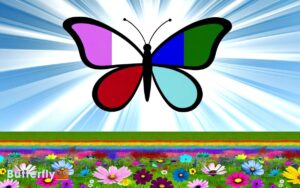How Do Orange Butterflies Symbolize in Different Cultures?
Orange butterflies symbolize transformation, spiritual growth, and the cyclical nature of life, drawing from both ancient mythology and medieval alchemy. The color orange, linked to the sacral chakra in Eastern philosophies, governs creativity and emotional balance.
Metamorphic processes in butterflies serve as vivid representations of renewal and continuous adaptation biologically and spiritually. In addition, the striking carotenoid-derived hue enhances the symbolic meanings of energy and dynamic change.
Observations of these butterflies are connected to emotional well-being, creativity, and more profound spiritual awareness, suggesting a broader significance in personal development and ecological health. Explore these multifaceted interpretations for a richer contextual understanding.
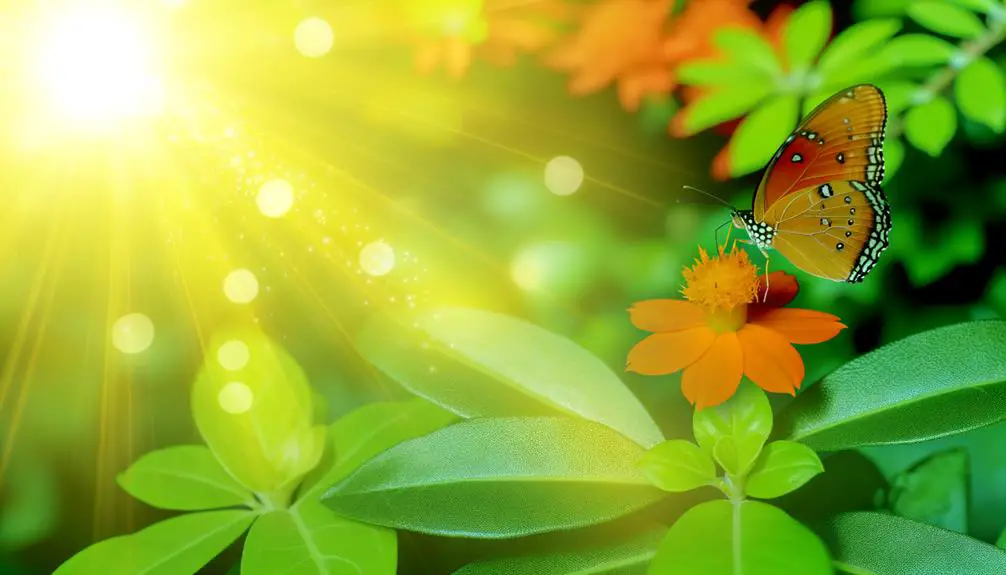
Key Takeaways
- Orange butterflies symbolize transformation and personal growth through their metamorphic life cycle.
- They represent joy and happiness, often associated with uplifting energy.
- In Eastern traditions, they signify spiritual rebirth and the life force.
- Orange butterflies are linked to creativity and artistic inspiration in Western symbolism.
Historical Significance
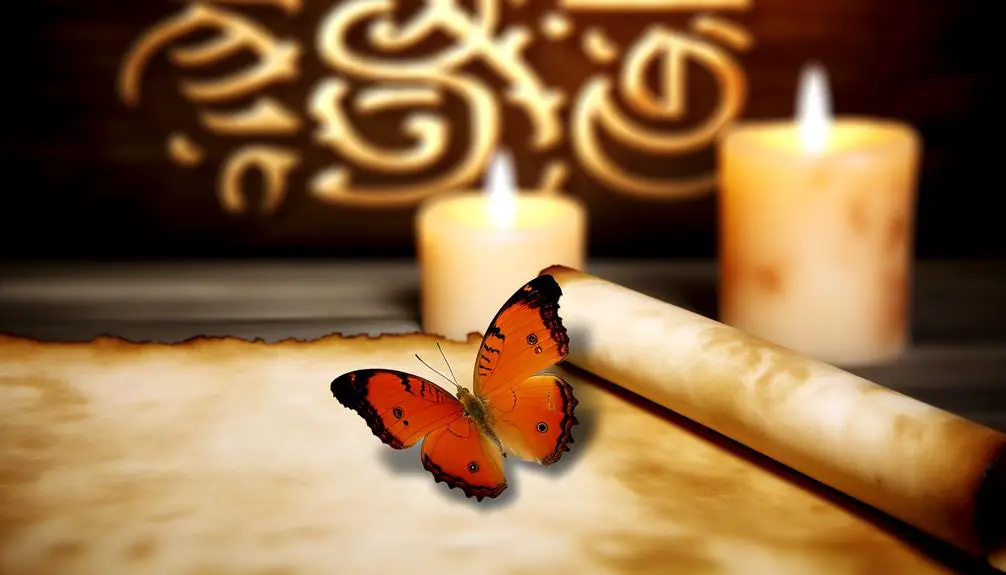
Throughout history, orange butterflies have held significant symbolic meanings across various cultures and civilizations, often representing transformation, spiritual growth, and the cyclical nature of life.
In ancient mythology, these butterflies were seen as harbingers of change, linked to the metamorphic process from caterpillar to butterfly. This transformation is a biological marvel involving intricate hormonal changes and cellular reorganization, symbolizing profound personal and communal evolution.
Additionally, in medieval alchemy, the color orange was associated with the element of fire, denoting purification and renewal, which further cemented the butterfly's status as an emblem of rebirth.
The vivid hue of orange butterflies also correlates with the sacral chakra in Eastern philosophies, signifying creativity and emotional balance, hence underscoring their historical symbolic importance.
Cultural Interpretations
Cultural interpretations of orange butterflies vary considerably across global contexts, with Eastern spiritual beliefs often attributing these insects to transformative and auspicious phenomena.
Conversely, Western artistic symbolism frequently employs the orange butterfly as a motif representing creativity, passion, and emotional depth.
Analyzing these disparate perspectives elucidates the multifaceted nature of orange butterflies in cultural symbology.
Eastern Spiritual Beliefs
In Eastern spiritual traditions, orange butterflies are often regarded as potent symbols of transformation, spiritual rebirth, and the life force. These beliefs are deeply rooted in the metaphysical principles of energy and consciousness.
The vibrant orange hue is linked to the sacral chakra, or Svadhisthana, which governs creativity, passion, and emotional balance.
In Taoism, the butterfly is seen as an emblem of the soul, reflecting its continuous journey of evolution and enlightenment. Similarly, in Hinduism, reincarnation and the cyclical nature of existence are mirrored in the butterfly's metamorphosis from caterpillar to adult.
Consequently, the appearance of an orange butterfly is interpreted as a divine message, encouraging personal growth and spiritual awakening. This vibrant creature serves as a reminder to embrace transformation and trust the journey ahead. Similarly, brown butterfly symbolism is often associated with stability and a deep connection to the earth, grounding individuals during times of change. Both colors carry profound spiritual meanings, guiding individuals toward self-discovery and inner wisdom.
Western Artistic Symbolism
While Eastern spiritual traditions imbue orange butterflies with profound metaphysical significance, Western artistic symbolism often interprets these vibrant insects as representations of creativity, transformation, and the ephemeral nature of beauty.
In Western art, the orange butterfly's vivid hue is frequently associated with the creative spark and artistic inspiration. Detailed studies in color theory suggest that orange stimulates enthusiasm and innovation, which artists have historically embodied in their works.
Additionally, the butterfly's metamorphic life cycle serves as a potent symbol of transformation and personal growth.
The transient nature of the butterfly's existence also underscores the fleeting, delicate beauty that characterizes much of Western aesthetic and philosophical thought, highlighting the importance of cherishing each moment.
Transformation and Change
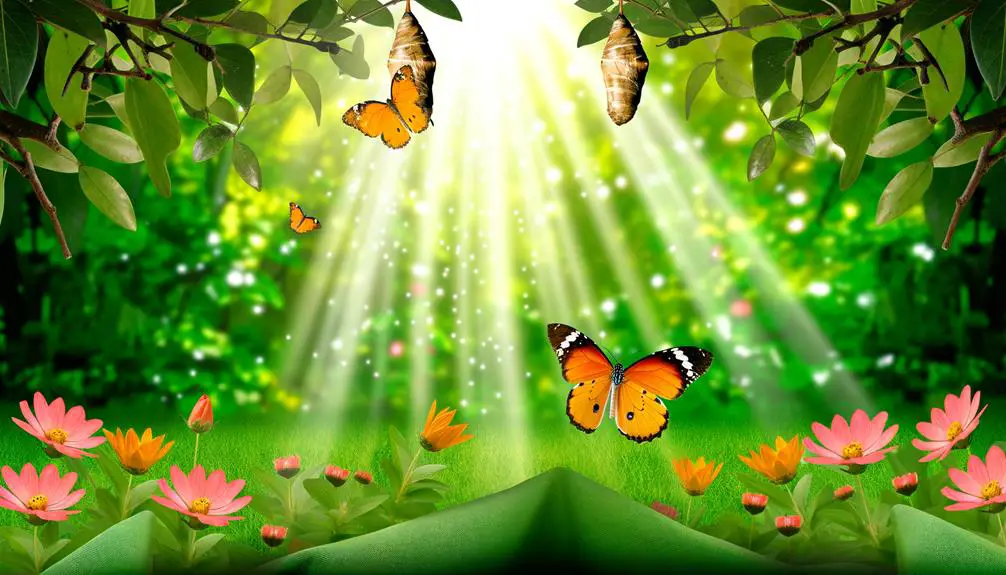
Orange butterflies, as agents of transformation and change, encapsulate the biological phenomena of metamorphosis and renewal inherent in their life cycle.
This intricate process mirrors the concept of embracing new beginnings, symbolizing a shift from one life stage to another.
Additionally, the presence of orange butterflies often represents an individual's personal growth journey, reflecting the continuous adaptation and development required for self-improvement.
Metamorphosis and Renewal
Embodying the principles of metamorphosis and renewal, orange butterflies serve as a vivid representation of the transformative processes inherent in nature's lifecycle.
The lifecycle of a butterfly, encompassing the stages of egg, larva (caterpillar), pupa (chrysalis), and adult, exemplifies the concept of metamorphosis. During the pupal stage, significant physiological changes occur, driven by hormonal regulation and gene expression, culminating in the emergence of a fully formed butterfly. This biological transformation symbolizes renewal and the continuous cycle of life.
The vibrant orange hue of these butterflies can be linked to the presence of carotenoids and other pigments, further enhancing their symbolic representation of energy and liveliness.
Consequently, orange butterflies epitomize the dynamic processes of transformation and biological renewal.
Embracing New Beginnings
The emergence of orange butterflies from their chrysalides is a scientific exemplar of embracing new beginnings, wherein the metamorphic process signifies profound biological and environmental transformations.
During metamorphosis, the larval cells undergo apoptosis, while the imaginal discs differentiate to form adult structures such as wings and antennae. This developmental change is regulated by hormonal cues, particularly ecdysteroids, which orchestrate cellular reorganization and tissue differentiation.
The resultant butterfly, often vividly orange, embodies a successful adaptation to new ecological niches. This transformation is not merely aesthetic; it represents a shift in behavior, feeding patterns, and reproductive strategies, underscoring the broader concept of ecological resilience and adaptability.
Consequently, orange butterflies epitomize the intricate balance between destruction and creation inherent in new beginnings.
Personal Growth Journey
How does the metamorphic journey of an orange butterfly serve as a scientific allegory for personal growth, illustrating the complex interplay of genetic, hormonal, and environmental factors that drive transformation and change in both biological and human contexts?
The metamorphosis from caterpillar to butterfly is orchestrated by precise genetic expressions and hormonal shifts, such as ecdysone and juvenile hormone, influenced by environmental cues. This intricate process mirrors the human experience of personal growth, where transformation is driven by both internal and external stimuli.
- Genetic Factors: DNA transcription and gene expression are pivotal in cellular differentiation.
- Hormonal Influences: Hormones regulate developmental stages and physiological changes.
This allegory underscores the multifaceted nature of growth and transformation.
Joy and Happiness
In many cultures, the vibrant hue of orange butterflies is often associated with the emotions of joy and happiness, symbolizing the uplifting and invigorating energy that these creatures bring to their surroundings. The presence of orange butterflies can trigger the release of serotonin and dopamine—neurotransmitters responsible for mood regulation and emotional well-being. These butterflies serve as natural indicators of a healthy ecosystem, which inherently brings a sense of joy to those who observe them. Additionally, their striking coloration is a visual stimulant that can enhance one's mood and overall sense of happiness.
| Observation | Effect on Humans | Biological Basis |
|---|---|---|
| Vibrant Color | Mood Enhancement | Visual Stimulation |
| Natural Presence | Emotional Well-being | Ecosystem Health |
| Serotonin Release | Increased Joy | Neurotransmitter Activation |
| Dopamine Release | Elevated Happiness | Mood Regulation Mechanism |
Creativity and Inspiration
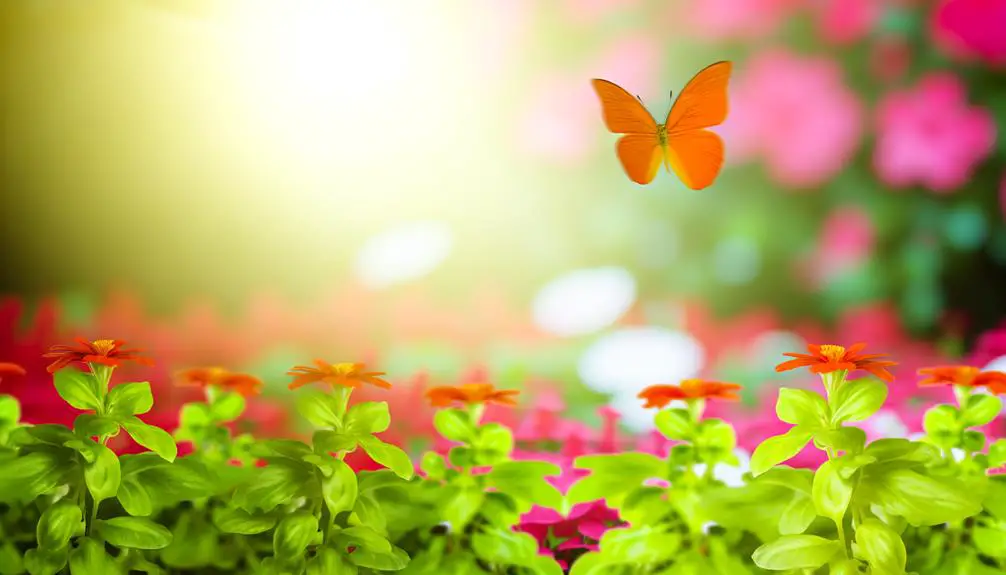
Beyond their association with joy and happiness, the vibrant presence of orange butterflies also greatly influences creativity and inspiration, acting as catalysts for imaginative thought and artistic expression.
The striking coloration of these butterflies has been scientifically shown to stimulate the visual cortex, promoting neural activity associated with creative processes. This phenomenon can be observed in various domains:
- Visual Arts: The intricate patterns and vivid hues encourage artistic endeavors, from painting to digital design.
- Literature: The symbolism of transformation and beauty often leads to poetic and narrative inspiration.
These aspects underscore the multifaceted role of orange butterflies in fostering human creativity.
Spiritual Growth
In the context of spiritual growth, orange butterflies are emblematic of transformation and renewal, serving as catalysts for personal metamorphosis.
These creatures also symbolize the awakening of inner peace, fostering a balanced and harmonious state of being.
Additionally, their presence is often associated with enlightenment and heightened awareness, guiding individuals towards a deeper understanding of their spiritual journey.
Transformation and Renewal
Orange butterflies, through their metamorphic life cycle, serve as a profound symbol of spiritual transformation and renewal, illustrating the process of growth and rebirth.
The shift from caterpillar to butterfly is emblematic of significant change, underscoring the potential for profound personal evolution. This metamorphosis can be scientifically understood as a series of developmental stages: egg, larva, pupa, and adult. Each stage represents a different phase of growth, ultimately culminating in the emergence of the butterfly.
- Egg Stage: Symbolizes the inception of new ideas or beginnings.
- Pupa Stage: Represents introspection and internal development.
Thus, the orange butterfly's lifecycle is a reflection of enduring transformation and the continuous journey of self-renewal.
Inner Peace Awakening
The presence of orange butterflies can catalyze an awakening of inner peace, serving as a visual and symbolic reminder of the profound spiritual growth that accompanies achieving a balanced and serene state of mind.
From a neurobiological standpoint, the vibrant orange coloration can trigger dopamine release, fostering a sense of well-being.
Symbolically, the butterfly's metamorphosis represents personal transformation, aligning with the psychological concept of individuation, where an individual integrates various aspects of the self into a harmonious whole.
This convergence of visual stimuli and symbolic meaning propels the observer toward a meditative state, enhancing mindfulness and emotional equilibrium.
Consequently, the orange butterfly becomes a potent emblem in the journey towards inner peace and spiritual maturation.
Enlightenment and Awareness
As individuals experience the calming influence of inner peace catalyzed by the presence of orange butterflies, they may also find themselves on a path toward deeper enlightenment and heightened spiritual awareness. The vibrant hue of orange butterflies stimulates the sacral chakra, enhancing creative energy and emotional equilibrium. This connection fosters a receptivity to profound spiritual insights, facilitating personal growth and self-realization.
- Chakra Activation: Orange butterflies are linked to the sacral chakra, promoting creative and emotional balance.
- Symbolic Resonance: Their presence often signifies the emergence of spiritual wisdom and intuitive understanding.
Such encounters can therefore act as catalysts for significant spiritual transformation.
Emotional Healing
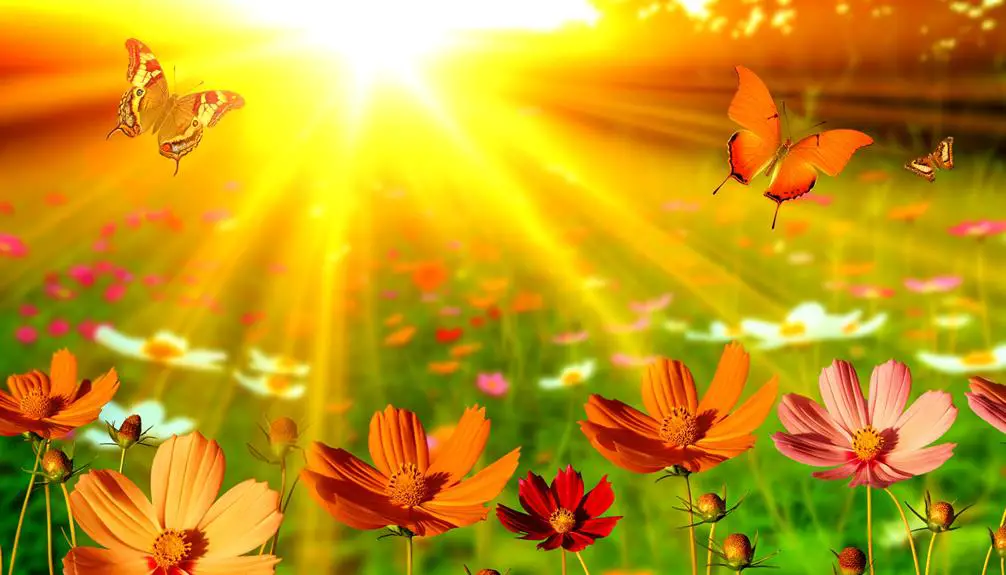
Symbolically, orange butterflies are often associated with emotional healing due to their vibrant color, which can stimulate feelings of warmth, enthusiasm, and rejuvenation. This chromatic influence is underpinned by color psychology, where orange is seen as a blend of red's energy and yellow's happiness. This amalgamation fosters a sense of emotional equilibrium, promoting mental wellbeing and resilience.
| Emotional Aspect | Influence of Orange Butterflies |
|---|---|
| Warmth | Fosters a comforting presence |
| Enthusiasm | Encourages positive engagement |
| Rejuvenation | Supports emotional renewal |
Moreover, the delicate yet transformative journey of butterflies from caterpillar to chrysalis to adult can mirror personal growth and emotional recovery, making them powerful symbols in therapeutic contexts. This symbolism can be particularly effective in visual and narrative therapies.
Love and Passion
Orange butterflies, with their vivid hue, are emblematic of love and passion. Their striking coloration evokes intense emotions and stimulates the heart's vibrancy.
The pigmentation of orange in butterflies is often due to carotenoid pigments, which absorb light in the blue and green spectrum, giving rise to their intense, warm tones. This coloration can be interpreted as a biological signal of liveliness and reproductive fitness, attracting mates and fostering romantic symbolism.
Moreover, the presence of orange butterflies in various cultures is often associated with romantic and passionate encounters.
- Carotenoid presence: Indicates health and reproductive potential.
- Visual stimulus: Sparks emotional and physiological responses.
Understanding these factors can deepen appreciation for their symbolic meanings.
Connection to Nature
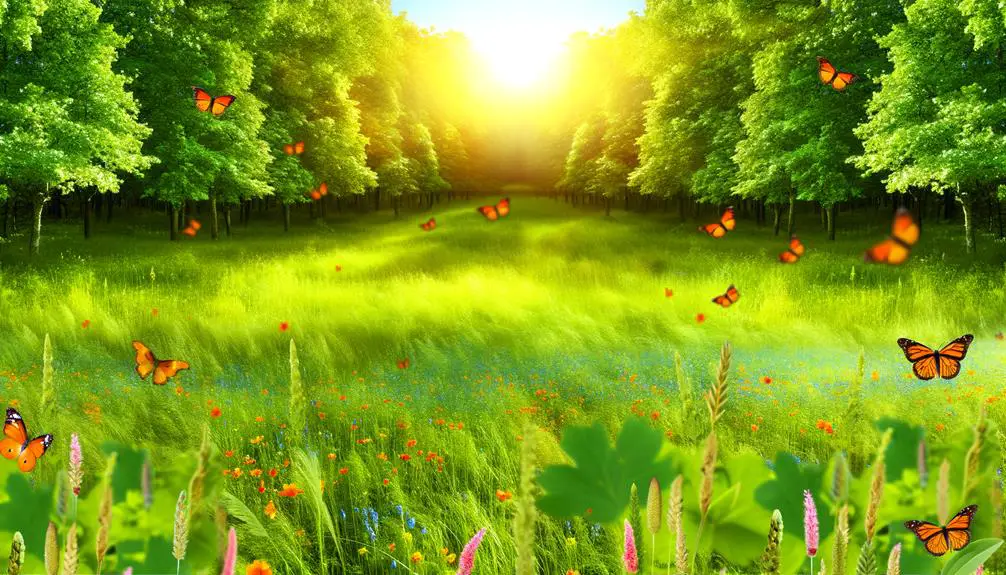
In examining the connection to nature, the presence of orange butterflies often signifies healthy ecosystems, as their vibrant coloration and interaction with flora indicate biodiversity and ecological balance.
These lepidopterans act as pollinators, contributing to the reproductive success of numerous plant species. Their larvae primarily feed on host plants, which necessitates a variety of flora to sustain diverse butterfly populations.
Predatory avoidance through aposematic coloration—warning predators of potential toxicity—additionally underscores their role in the intricate web of life.
Moreover, the presence of orange butterflies can be an indicator of environmental quality, as they are sensitive to habitat changes and pollutants.
Consequently, their thriving populations reflect a well-maintained, resilient natural environment, essential for ecological equilibrium.
Symbol in Dreams
Dreams featuring orange butterflies often represent transformation and personal growth, rooted in Jungian psychology and the archetypal symbolism of metamorphosis.
The vibrant orange hue is associated with emotional balance and enthusiasm, suggesting an awakening or renewal within the dreamer's psyche. This symbol is particularly potent when considering the life cycle of butterflies, which undergo significant change from caterpillar to winged adult.
Key aspects highlighted by orange butterflies in dreams include:
- Emotional Rebirth: Signifying the emergence of new emotional states or perspectives.
- Personal Growth: Reflecting an internal journey towards self-improvement and enlightenment.
These interpretations align with the broader understanding of butterflies as symbols of change and evolution.
Personal Encounters
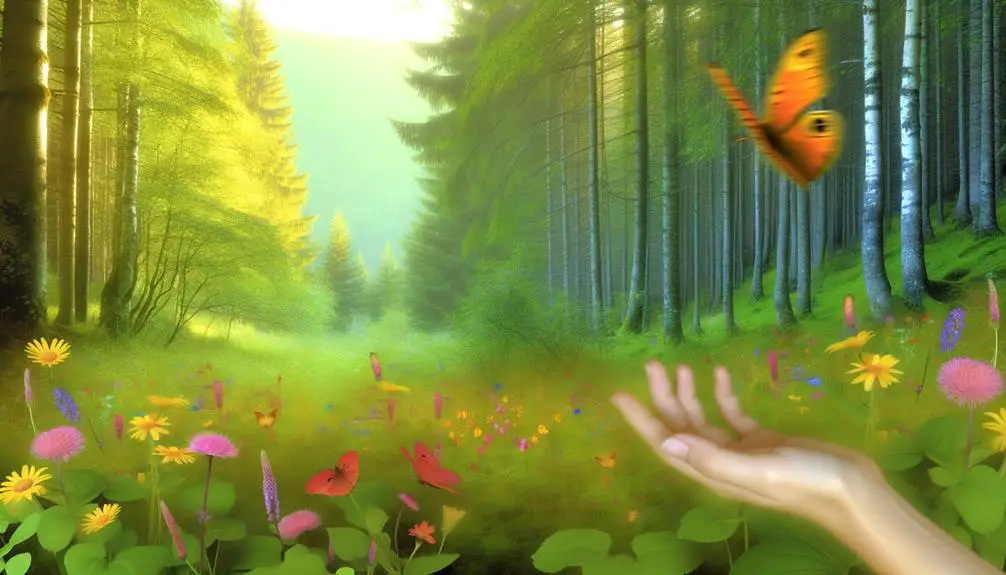
Through anecdotal evidence and documented case studies, personal encounters with orange butterflies often reveal deep psychological and emotional significance tied to their symbolic essence.
These encounters are frequently associated with transformative life events, such as personal growth or emotional healing.
Psychologists have noted the prevalence of orange butterflies in therapeutic settings, suggesting their presence may facilitate introspection and emotional release.
Biologists emphasize the visual impact of the butterfly's coloration, which can trigger heightened states of awareness and mindfulness.
Additionally, cultural anthropologists highlight that different societies attribute specific meanings to these encounters, ranging from messages of hope to symbols of the soul's journey.
Such interdisciplinary perspectives underscore the multifaceted importance of orange butterflies in human experiences.
Conclusion
To summarize, the orange butterfly, with its vibrant hue, serves as a multifaceted symbol deeply rooted in historical, cultural, and personal contexts.
It embodies transformation, joy, creativity, love, and a profound connection to nature.
Like a fleeting moment of brilliance, this delicate creature captures the essence of change and inspiration.
Whether encountered in dreams or in nature, the orange butterfly's symbolism resonates through various dimensions, painting a vivid tapestry of meanings that transcend mere aesthetics.




